Presidents 4 - 6
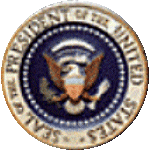

James Madison
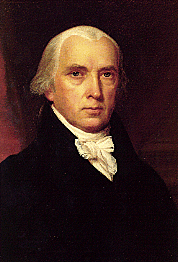
In May, 1787, a short, thin young man named James Madison traveled to
Philadelphia to attend the Constitutional Convention. The Articles of
Confederation had not provided the United States with a workable government
after the American Revolution. Madison was one of many who called for a new
national government. At age 36, Madison was one of the youngest members of the
convention. He also was the best prepared.
For months, Madison had secluded himself on his father's plantation in
Virginia. There, he read stacks of books on history, politics, and commerce.
He arrived in Philadelphia with a case bulging with research. For his work at
the convention, Madison became known as "Father of the
Constitution."
James Madison was born on March 16, 1751, at Port Conway, Virginia. In 1771,
he graduated from the College of New Jersey (present-day Princeton
University), but returned to Virginia and entered politics at the time of the
American Revolution. Thomas Jefferson soon met and befriended the younger man
and became Madison's mentor.
In many ways, Madison was an odd person to become a leading statesman. At five
feet, four inches tall, he weighed only 100 pounds. He was very shy with men
(and even shyer with women) and usually spoke in a low voice that was
difficult to hear. But what Madison may have lacked in physical stature was
more than compensated for by a sharp, fine mind.
Madison first came to national attention at the Constitutional Convention. He
and Edmund Randolph proposed the "Virginia Plan" for a national
government. The plan called for three branches: executive, legislative, and
judicial. It became the basis for the United States Constitution. The daily
notes that Madison took during the proceedings have enabled later generations
of Americans to know how the framers of the Constitution made their decisions.
Once the constitution was written, Madison worked hard to persuade the states
to ratify it. Along with Alexander Hamilton and John Jay, he wrote a series of
essays, The Federalist Papers, which explained the need for the constitution
and argued for its acceptance.
Madison won election to the House of Representatives in 1789. During his
tenure he introduced the Bill of Rights and guided it through Congress. He
served as Secretary of State during Jefferson's administration. When Jefferson
retired from office in 1808, Madison ran for President on the
Democratic-Republican ticket. He defeated the Federalist candidate, Charles
Pinckney, to become the fourth President of the United States.
The greatest problem of Madison's administration was foreign affairs. England
and France were at war with each other, and both countries seized American
ships to keep them from trading with the enemy. Because England had a larger
navy, it was more successful at interfering with American commerce than
France. Some members of Congress pressed for war with England in the hope of
invading and seizing Canada. These "War Hawks" criticized Madison's
cautious diplomacy and clamored for war. By June of 1812, feeling that he had
no choice, Madison asked Congress to declare war on England.
The War of 1812 turned out to be a costly mistake. American armies at the
Canadian border were defeated, and Madison lost support from New England
states which suffered from the loss of trade. A British force captured
Washington, D.C. in 1814 and burned the White House and the Capitol. First
Lady Dolley Madison managed to save some presidential papers and a portrait of
George Washington by fleeing with them before the British arrived. The war
finally ended in a stalemate, though the United States had proved its military
might.
Madison retired after his second term in 1817. His home, called Montpelier,
was not far from Jefferson's Monticello. Besides running his own plantation,
he helped Thomas Jefferson found the University of Virginia. James Madison
always will be best remembered as the architect of the American government.
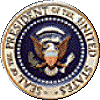
James Monroe
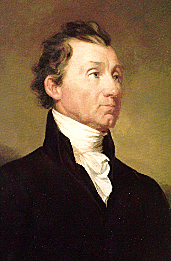
When James Monroe ran for presidential reelection in 1820, no one opposed him.
His first term in office had been calm and successful. Party politics were
less antagonistic, the country was at peace, and the economy was healthy. The
electoral college cast only one vote against Monroe, possibly because the
electors wanted George Washington to retain the honor of being the only
President elected unanimously.
James Monroe was born on April 28, 1758, in Westmoreland County, Virginia. He
left college to fight in the Continental Army during the American Revolution.
After bravely leading a charge at the Battle of Trenton and being severely
wounded in the shoulder, Monroe was promoted to captain by George Washington.
After the war, Monroe studied law under Thomas Jefferson and began a
successful political career. A tall, broad-shouldered man with a warm and
considerate personality, Monroe was well-liked and respected by those who knew
him, and popular with the public. He was elected to the Virginia Assembly and
served in the Congress of the Confederation between 1783 and 1786. Monroe also
served as a member of the Senate, and President Washington named him
ambassador to France. In 1799, he was elected governor of Virginia. President
Jefferson sent him to France again to negotiate the purchase of New Orleans.
Monroe did one better, helping to buy the Louisiana Territory for $15 million.
During the War of 1812, Madison made Monroe Secretary of State, and in 1814
named him Secretary of War.
With so much experience in public affairs, Monroe was the choice of both
Jefferson and Madison to be the Republican candidate for President in 1816.
Although the Republicans had lost support because of the War of 1812, victory
at the Battle of New Orleans and the news of peace revived the party's hopes.
Monroe easily defeated the Federalist candidate, Rufus King.
Monroe's administration, which spanned two terms, is noted for several
achievements in foreign policy. Relations improved with Great Britain, and
tensions eased along the American-Canadian border. In 1819, Spain sold Florida
to the United States for $5 million, expanding the country from 15 to 24
states during Monroe's administration.
Monroe is best remembered for the Monroe Doctrine. In 1823, Spain plotted to
regain control of its former colonies in South America. Many of these colonies
had had revolutions of their own and were now independent republics. When
Spain began looking for help from other European powers to recapture these
countries, Monroe made a speech in Congress. He warned Europe to stay away
from the Americas. The Monroe Doctrine has been a major part of American
foreign policy ever since.
In 1825, Monroe retired to his Virginia home. Although he was plagued by debts
(the government owed him thousands of dollars in back pay), he could take some
satisfaction in his popularity and the achievements of his political career.
The United States was so prosperous and united during the Monroe years that
the period has become known as "the Era of Good Feelings."

John Quincy Adams
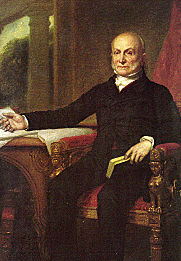
When John Quincy Adams was just 8 years old, his mother Abigail took him to
watch the Battle of Bunker Hill from a nearby hill in Boston. Because he was
the son of John and Abigail Adams, John Quincy Adams found himself in the
center of American politics from the moment he was born.
Born in Braintree (present-day Quincy), Massachusetts, John Quincy Adams spent
most of his teenage years in Europe. He joined his father on a diplomatic
mission to Europe in 1778, and in 1782 he became the secretary to the American
ambassador to Russia. He was only 14 years old. The following year, John
Quincy served as his father's secretary while John Adams was in Paris helping
to negotiate the treaty that ended the American Revolution.
John Quincy Adams returned to America to study law at Harvard College. He
didn't get much of a chance to practice, however, because President Washington
appointed him ambassador to the Netherlands in 1794. Although many people
thought that Adams had a cold and reserved personality, he was one of the
nation's most successful diplomats. President John Adams named his son
ambassador to Prussia. President Madison made him ambassador to Russia, and
later ambassador to Great Britain. President Monroe made John Quincy Adams his
Secretary of State.
With a wealth of diplomatic experience under his belt, Adams ran for President
in 1824. The only opposing candidate with truly national appeal was the hero
of the War of 1812, Andrew Jackson. Although Jackson got more votes than any
other candidate, he did not win a majority, and the election was thrown into
the House of Representatives. Henry Clay urged his supporters to vote for
Adams, and he won the presidency. When Adams appointed Clay his Secretary of
State, Jackson's supporters claimed that a "corrupt bargain" had
been struck.
Adams was interested in developing the country's infrastructure and encouraged
the government to build roads, railroads, and canals. Although Congress was
reluctant to spend the money, a few of Adams's projects were approved. The
Erie Canal was completed during his presidency, and the Chesapeake and Ohio
Canal project was begun.
In 1828, Adams ran for reelection against Andrew Jackson, but was defeated.
Many speculated that he wanted to lose, as he had been known to comment that
the presidency was "a . . . harassing, wearying, teasing condition of
existence."
Adams went back to Braintree, only to return to Washington as a member of
Congress. Serving in the House of Representatives from 1831 to 1848, he
campaigned to restore debate on abolition, which had been stopped by a
"gag rule."
Adams seemed to enjoy his career as legislator more than his role as
President, and earned the nickname "Old Man Eloquent." Adams was at
his desk in the Capitol in 1848 when he suffered a stroke. He died two days
later, after a lifetime of service to his country.

All images of Presidents are courtesy of whitehouse.gov
Information taken from Software titled "American Heritage The History of
the United States for Young People.
The copyright belongs to: Forbes
Inc. and Byron Preiss Multimedia Company. Thank You!

Washington, Adams, Jefferson
Madison, Monroe, Adams
Jackson, Van Buren, Harrison
Tyler, Polk, Taylor
Fillmore, Pierce, Buchanan
Lincoln, Johnson, Grant
Hayes, Garfield, Arthur
Cleveland, Harrison, Cleveland
McKinley, T. Roosevelt, Taft
Wilson, Harding, Coolidge
Hoover, F. Roosevelt, Truman
Eisenhower, Kennedy, Johnson
Nixon, Ford, Carter
Reagan, Bush, Clinton
Bush, ????, ????
|

|
All graphics and
pages are copyright © 1997 - 2008 Pages 4 Ever
(except where noted). Do not take, copy, steal, plagiarize or use in any
way, shape or format without the express written permission of Pages
4 Ever.
Some backgrounds and graphics made from clipart acquired from ArtToday, Boxed Art,
friends, my own imagination, and/or
graphic CD collections that I have purchased. If you find anything on this site
that you have copyright to, and can prove it, please let me know and I will
gladly either remove it or place a link back to you, whichever you prefer.
If you should find any broken links, please drop us a line and let us know the
exact URL the broken link is on. Thank you.
|

|
![]()





